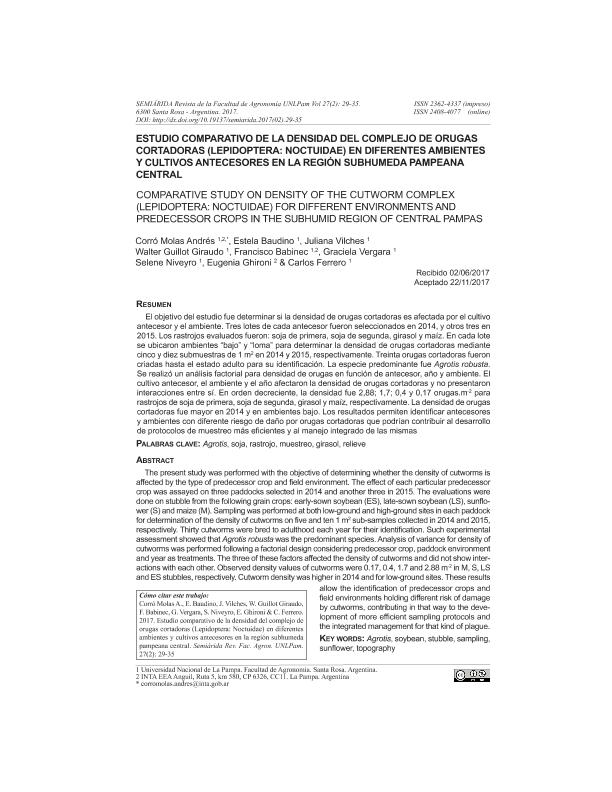Artículo
El objetivo del estudio fue determinar si la densidad de orugas cortadoras es afectada por el cultivo antecesor y el ambiente. Tres lotes de cada antecesor fueron seleccionados en 2014, y otros tres en 2015. Los rastrojos evaluados fueron: soja de primera, soja de segunda, girasol y maíz. En cada lote se ubicaron ambientes “bajo” y “loma” para determinar la densidad de orugas cortadoras mediante cinco y diez submuestras de 1 m2 en 2014 y 2015, respectivamente. Treinta orugas cortadoras fueron criadas hasta el estado adulto para su identificación. La especie predominante fue Agrotis robusta. Se realizó un análisis factorial para densidad de orugas en función de antecesor, año y ambiente. El cultivo antecesor, el ambiente y el año afectaron la densidad de orugas cortadoras y no presentaron interacciones entre sí. En orden decreciente, la densidad fue 2,88; 1,7; 0,4 y 0,17 orugas.m2 para rastrojos de soja de primera, soja de segunda, girasol y maíz, respectivamente. La densidad de orugas cortadoras fue mayor en 2014 y en ambientes bajo. Los resultados permiten identificar antecesores y ambientes con diferente riesgo de daño por orugas cortadoras que podrían contribuir al desarrollo de protocolos de muestreo más eficientes y al manejo integrado de las mismas. The present study was performed with the objective of determining whether the density of cutworms is affected by the type of predecessor crop and field environment. The effect of each particular predecessor crop was assayed on three paddocks selected in 2014 and another three in 2015. The evaluations were done on stubble from the following grain crops: earlysown soybean (ES), latesown soybean (LS), sunflower (S) and maize (M). Sampling was performed at both lowground and highground sites in each paddock for determination of the density of cutworms on five and ten 1 m2 subsamples collected in 2014 and 2015, respectively. Thirty cutworms were bred to adulthood each year for their identification. Such experimental assessment showed that Agrotis robusta was the predominant species. Analysis of variance for density of cutworms was performed following a factorial design considering predecessor crop, paddock environment and year as treatments. The three of these factors affected the density of cutworms and did not show interactions with each other. Observed density values of cutworms were 0.17, 0.4, 1.7 and 2.88 m2 in M, S, LS and ES stubbles, respectively. Cutworm density was higher in 2014 and for lowground sites. These results allow the identification of predecessor crops and field environments holding different risk of damage by cutworms, contributing in that way to the development of more efficient sampling protocols and the integrated management for that kind of plague.
Estudio comparativo de la densidad del complejo de orugas cortadoras (Lepidoptera: Noctuidae) en diferentes ambientes y cultivos antecesores en la región subhúmeda pampeana central
Título:
Comparative study on density of the cutworm complex (lepidoptera: noctuidae) for different environments and predecessor crops in the subhumid region of central Pampas
Corró Molas, Andrés Ezequiel; Baudino, Estela Maris; Vilches, Juliana; Guillot Giraudo, Walter ; Babinec, Francisco José; Vergara, Graciela; Niveyro, Selene Leonor
; Babinec, Francisco José; Vergara, Graciela; Niveyro, Selene Leonor ; Ghironi, Eugenia; Ferrero, Carlos Jose
; Ghironi, Eugenia; Ferrero, Carlos Jose
 ; Babinec, Francisco José; Vergara, Graciela; Niveyro, Selene Leonor
; Babinec, Francisco José; Vergara, Graciela; Niveyro, Selene Leonor ; Ghironi, Eugenia; Ferrero, Carlos Jose
; Ghironi, Eugenia; Ferrero, Carlos Jose
Fecha de publicación:
12/2017
Editorial:
Universidad Nacional de La Pampa. Facultad de Agronomía
Revista:
Semiárida
ISSN:
2362-4337
Idioma:
Español
Tipo de recurso:
Artículo publicado
Clasificación temática:
Resumen
Palabras clave:
Agrotis
,
Soja
,
Rastrojo
,
Muestreo
,
Girasol
,
Relieve
Archivos asociados
Licencia
Identificadores
Colecciones
Articulos(SEDE CENTRAL)
Articulos de SEDE CENTRAL
Articulos de SEDE CENTRAL
Citación
Corró Molas, Andrés Ezequiel; Baudino, Estela Maris; Vilches, Juliana; Guillot Giraudo, Walter; Babinec, Francisco José; et al.; Estudio comparativo de la densidad del complejo de orugas cortadoras (Lepidoptera: Noctuidae) en diferentes ambientes y cultivos antecesores en la región subhúmeda pampeana central; Universidad Nacional de La Pampa. Facultad de Agronomía; Semiárida; 27; 2; 12-2017; 29-35
Compartir



